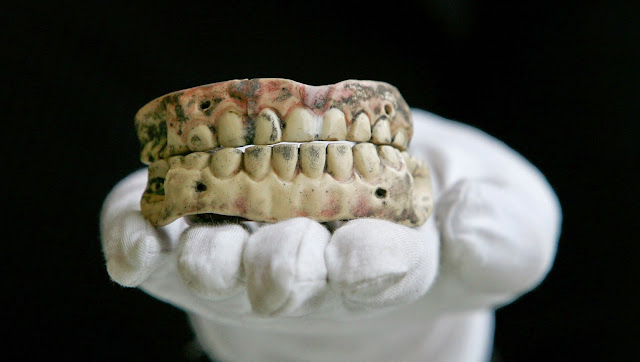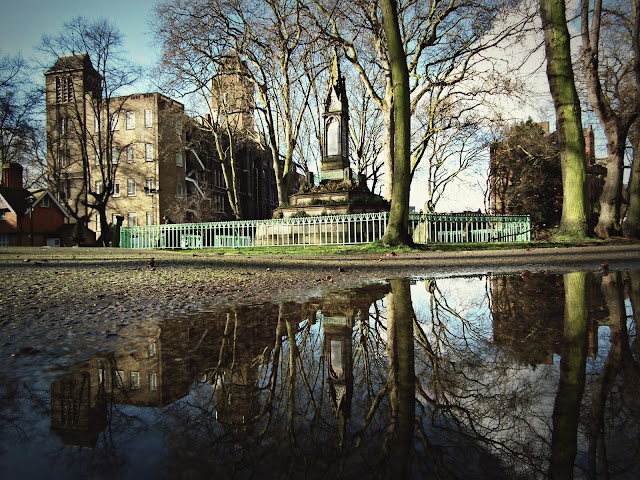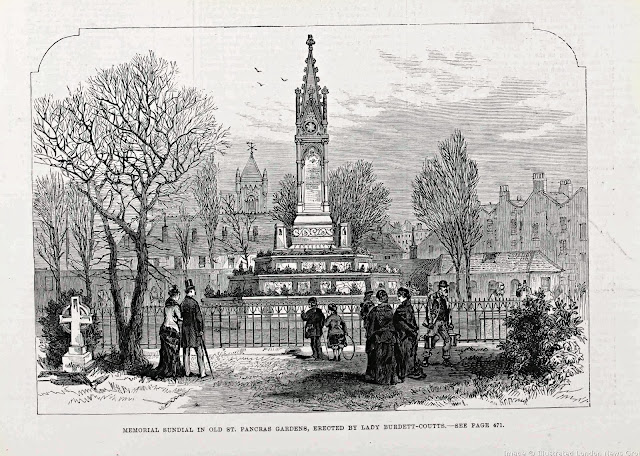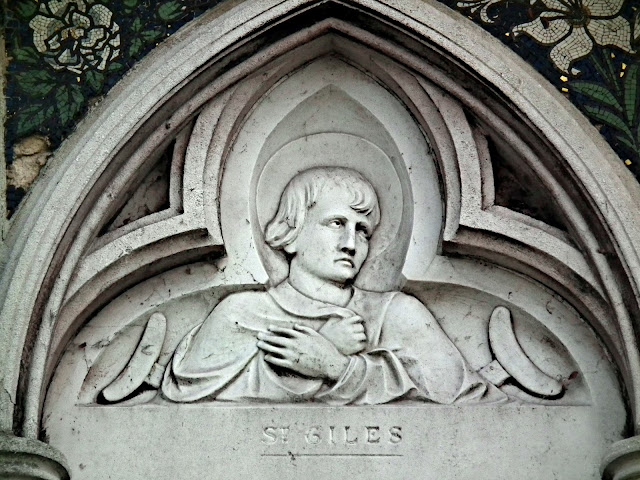 |
| d'Eon's entry in the St Pancras burial register |
The
counter-examinations and declarations of the two sets of Surgeons respecting the
sex of the late Chevalier d'Éon, reminds us of the examination of a well-known
blockhead at Cambridge for his degrees, who, as the last question was asked,
Whether the sun revolved round the Earth, the Earth round the Sun?” replied, as
the Chirurgical Gentry might perhaps, with more propriety have done—“Sometimes
the one, sometimes the other.”
Bristol Mirror - Saturday 02 June 1810
The body of the
late Chevalier d'Éon, was privately interred within the parish church of St.
Pancras, on Monday morning ; on the coffin was inscribed: - Charles Genevieve
Louis Auguste Andre Timothe d'Éon de Beaumont, ne 17 Octobre, 1727. mort. 21
Mai 1810." The Duke of Queensbury
allowed the Chevalier D'Eon an annuity of £50 to the day of his death.
Lancaster Gazette - Saturday 02 June 1810
In
1913, when Havelock Ellis, the great pioneering British sexologist, turned his
attention to transgender phenomena, needing a name for it but disliking the term
transvestism invented by his German
rival Magnus Hirschfield, he came up with the clumsy alternative sexo-aesthetic inversion. He soon
realised that his 23 letter 3 word rival to transvestite
was never going to catch on (“I’m just a sweet sexo-aesthetic invert, from
sexo-aesthetic invertual Transylvania….” The Rocky Horror Show has a lot to
thank Hirschfield for….). In 1920, casting around for a substitute, Ellis stumbled
upon the details of the 18th century career of Charles Genevieve de Beaumont, the
Chevalier d'Éon and came up with the much snappier Eonism. Unfortunately transvestite was by then too well
established to be dislodged even by a term coined in honour of perhaps the most
celebrated cross dresser ever (except, perhaps, for James Barry).
 |
| The Chevalier as painted by Thomas Stewart |
Born
in 1728 in the pretty but sleepy Burgundian town of Tonnerre, the Chevalier d'Éon was the scion of
impoverished nobility, his father scraping a living as a royal official,
director of the king’s dominions, and eventually becoming Mayor of the
commune. He was a bright student who was
sent to study law in Paris when he was 15 and who eventually followed his
father into royal service by becoming a secretary to the intendant of Paris and
a royal censor of history and literature. He entered the shadowy world of
Bourbon espionage, the Secret du Roi, in
his late twenties and, by his own account (not always completely reliable) was
sent on a clandestine mission to the Empress Elizabeth in Russia. It was during
this episode that d'Éon first donned women’s clothing, disguising himself as
the Lea de Beaumont and passing
himself off as one of the Empress’ ladies-in-waiting. Louis XV awarded him 2000
livres for services rendered on his return to France where he temporarily hung
up his petticoats and cambric frocks and instead kitted himself out in a
dragoon’s uniform before setting off to fight in the seven years war. At the
end of that conflict the King dispatched him to London where he helped draft
the peace treaty and discovered a taste for the former enemy’s capital. A
reward of 6000 livres, the Order of St Louis, the title of Chevalier and the
post of chargé d'affaires at the London Embassy were d'Éon’s rewards this time.
He was clearly ambitious and acted as interim ambassador when the duc de
Nivernais was recalled to Paris, using the freedom from supervision to spy
privately for the King. When the Comte de Guerchy was appointed as the new
ambassador the humiliated d'Éon was promptly demoted to secretary. Seething with resentment d'Éon caused endless
trouble at the embassy and eventually received orders to return home. When he refused to obey orders the British
authorities were asked to extradite the stubborn secretary but they declined to
involve themselves in the dispute. When the French stopped paying his salary the
Chevalier retaliated by publishing reams of secret diplomatic correspondence
but taking care to keep back the most damaging documents (relating to potential
French invasion plans). The French suddenly became very cautious in their
dealings with d'Éon even when he commenced a lawsuit against the ambassador for
attempted murder. The lawsuit failed and the ambassador sued for libel; d'Éon
was declared an outlaw and forced to go into hiding. Eventually the French
Government reached an agreement with d'Éon, paying him a pension in return for
his silence over the secret documents.
Despite
strutting around town in a dragoon’s uniform it was in London that the first
rumours about his true sex began to circulate, rumours quite likely started by
the Chevalier himself. 18th century
gentlemen loved to bet and speculation regarding the Chevaliers true sex became
so rife that money started to be staked on the controversy. Amongst others the Stock Exchange started a
betting pool and the stakes were sometimes astronomical; one Da Costa bet Mr
Jones £700 guineas that the Chevalier was a woman. When Da Costa felt he had
sufficient evidence he demanded settlement of the bet but Wallace refused on
the grounds that the evidence was unconvincing (the evidence seemed to simply
be the word of other gentlemen ‘in the know’). The matter ended up in the
courts where Britain’s most senior judge, Lord Mansfield, had the pleasure of
hearing it. The jury found for Da Costa, effectively setting up a legal
judgement that the Chevalier was indeed a woman. Lord Mansfield was unhappy
with the verdict and encouraged a retrial at which he ruled that the contract
for the wager was ineffective because it was not made in good faith; his issue
was the matter of the Chevalier’s sex could not be resolved with a gross
indecency and intrusion on his privacy. But as far as the British public were
concerned d'Éon was now a woman. Astonishingly the Chevalier seemed to agree;
it was from this period that he cast aside the dragoon’s uniform and started
dressing and living as a woman, initially in France where he had returned in
1777 only to find himself effectively under house arrest at the family estate
in Tonnerre. In France he claimed to have been born a girl and been forced by
his family, who were concerned that a female heir could not inherit the estate,
to pass as a male. He also claimed that the new king of France Louis XVI
accepted this story but only allowed him to retain the privileges of a male if
he wore women’s clothes. One memoirist later wrote that “the desire to see his native land once more determined him to submit to
the condition, but he revenged himself by combining the long train of his gown
and the three deep ruffles on his sleeves with the attitude and conversation of
a grenadier, which made him very disagreeable company.” In 1779 d'Éon published La Vie Militaire, politique, et privée de Mademoiselle d'Éon and
began petitioning to be allowed to return to England. He was only granted the
right to leave France and return to London in 1785. The 1789 revolution ended d'Éon’s
royal pension and he lived in straitened circumstances in England until his
death ending up in debtor’s prison at least once. He earned a living by taking
part in fencing tournaments dressed as a woman, a sight unusual enough to
guarantee sizeable crowds of punters willing to pay for the privilege.
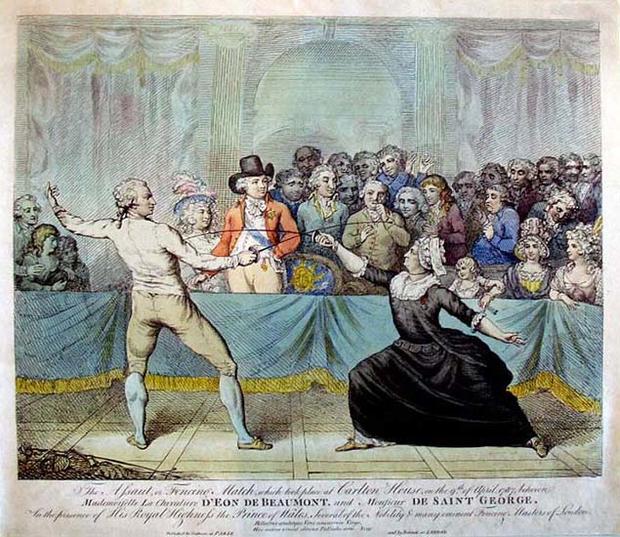 |
| "The Assault or Fencing Match which took place at Carton House on the 9th of April 1787" |
In
his final years the Chevalier lived with
an elderly widow, Mrs Cole, at her house in Millman Street, a thoroughfare
lined with small terraced houses mainly occupied by artisans and jobbing
craftsmen a short walk due south from Coram Fields and the Foundling
Hospital. The Chevalier was paralysed
through illness for four years before he died on Monday 21 May 1810. Mrs Cole
claimed to be astonished when she came to lay out her friends body because she
had never, not even for a second, suspected that he might be a man. What she
discovered on lifting the dead woman’s nightdress so disturbed her that she immediately
alerted the medical fraternity. On Wednesday 23 May in the tiny bedroom of the long
since demolished house a group of smartly dressed men gathered around the bed
on which lay the corpse of the 83 year old French (wo)man. They were a
distinguished assembly, mainly but not exclusively medical men but all ‘persons
of consideration’ according to newspaper reports. The group of at least 11
persons included Francis Seymour-Conway, the Earl of Yarmouth and member of
parliament for Lisburn, Rear admiral Sir Sidney Smith, Marie-Vincent
Talochon (‘Le père Elisée’), a 57 year old French émigré and former surgeon to Louis XVI who had attended d'Éon in
his last illness, Mr. Wilson, a
Professor of-Anatomy, Mr Ring and Mr
Burton, two respectable surgeons, Mr. Hoskins, a respectable solicitor, Mr.
Richardson, bookseller of Cornhill, the Hon. Mr. Lyttleton, Mr. Douglas, and a Mr Adair. Holding onto a corner of the
bedclothes was an up and coming member of the Royal College of Surgeons, Thomas
Copeland who had just celebrated his 29th birthday and, despite being back less
than a year from Spain where he did a stint as an army surgeon during the
Peninsular War, had already published the well received study Observations on some of the principal
Diseases of the Rectum. The group
watched in silence as Copeland pulled back the bedclothes and then, after
pausing to glance around the room, slowly exposed d'Éon thighs and pudenda. The lifted nightgown revealed withered thighs,
a rather distended belly and, nestling between them, a perfectly formed set of
male genitalia. A group of well bred British gentlemen would never do anything
as vulgar as gasp in astonishment and so the assembly had to content itself
with conveying their surprise by the furious raising of quizzical eyebrows.
In
a signed statement about the examination appended to a drawing of d'Éon’s cock
and balls Copeland later wrote “I hereby certify, that I have inspected and
dissected the body of the Chevalier D'Eon, in the presence of Mr. Adair, Mr.
Wilson and Le Pere Elizie and have found the male organ in every respect
perfectly formed. (Signed) T. Copeland, Surgeon, Golden-square.” It seems the medical men were not content with
just outward observation of this astonishing phenomenon; it was cut and sliced
open with scalpel and scissors until learned opinion was certain that they were
not dealing with something that merely resembled the male sexual organs but the
genuine thing. Perhaps there was some disappointment; no doubt at least a few
of the company would have been hoping for something more remarkable than an old
lady who turned out to be a man, at the very least a hermaphrodite.
 |
| Charles Turner's drawing of the Chevalier's profile based on the death mask |
The
following day Copeland was back at Millman Street bringing with him the
Professor of Anatomy at the Duke of York’s Hospital, Joseph Constantine Carpue and
a draughtsman Charles Turner. While Carpue examined the old lady’s corpse
Turner set about drawing the view between her flaccid thighs and also making a
death mask. Turner’s final drawing shows circumcised penis and testicles intact
and without the least sign of dissection.
As Copeland signed this last draught with the declaration that he had
inspected and dissected the body and
dated it the previous day, then Turner, for whatever reason, decided not to
show this post mortem intervention of the surgeon and drew the body as he
imagined it would have looked before Copeland got to work with his scalpel.
Carpue added his own statement to the drawing – “In consequence of a note from
the above Gentleman (Copeland) I examined the Body which was a Male. The
original drawing was made by Mr C. Turner in my presence. Dean Street, Soho,
May 24th 1810.” These were not the last visitors to view the Chevalier’s corpse;
according to the Morning Chronicle ““the body has been inspected by nearly 80
other gentlemen”, while the Morning Herald claimed ‘hundreds’ had been to
Millman Street:
The body of this
extraordinary character has undergone not only the anatomical inspection of the
whole faculty, hut also many hundreds of the most distinguished Curiosi of the
metropolis. Strange to say, the female visitants have exceeded those of the
other sex as three to one. His Highness the Duke of Gloucester, and several
other persons of distinction, were among the latter. It lies in a handsome oak
coffin, covered with black cloth, and a black velvet cross on the lid, at the
house of Mrs. Cole, of New Millman-street, to whose benevolent kindness and
attention, the Chevalier was indebted for the principal comforts of his latter
days. A cast was taken from the face on Friday. It is proposed to inter the
body in St. Pancras Church-yard the day after tomorrow.
On
the following Monday, the 28th May, d'Éon was buried in a private plot at St
Pancras, the coffin plate stating his name as the Chevalier Charles Geneviève Louis
Auguste André Timothée d'Éon de Beaumont; the burial register giving his age as
81. The Morning Advertiser alleged that “some minutia of his mortal remnants
are said to have been clandestinely conveyed away, to decorate the cabinets the
Medical Virtuosi.” The insults to the Chevaliers memory did not end there; exactly
a fortnight later the Morning Chronicle carried an outrageous advertisement
announcing that a few days hence, by subscription, could be purchased a copy of
the death mask of the Chevalier “also an engraving from the Original drawing of
THE BODY. The Engraving, when published, will be signed by Gentlemen of the
Faculty, testifying its correctness. Published and engraved by C. Turner, No.
50 Warren-street, Fitzroy-square.”
The Chevaliers grave was one of those later cleared to make way for St Pancras station and commemorated on the Burdett Coutts memorial.
The Chevaliers grave was one of those later cleared to make way for St Pancras station and commemorated on the Burdett Coutts memorial.
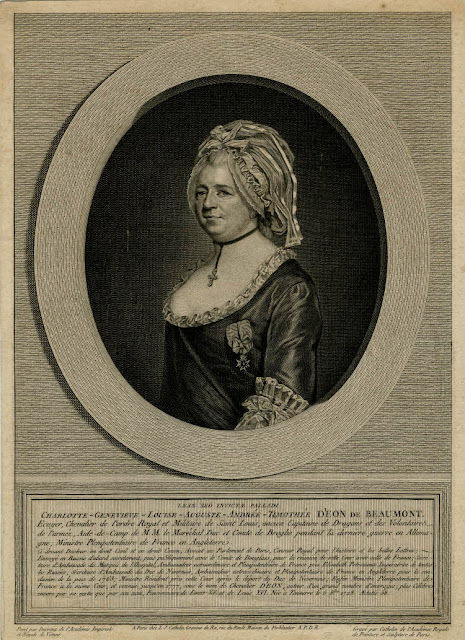

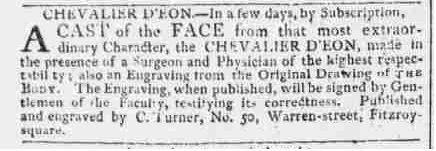








.jpg)
